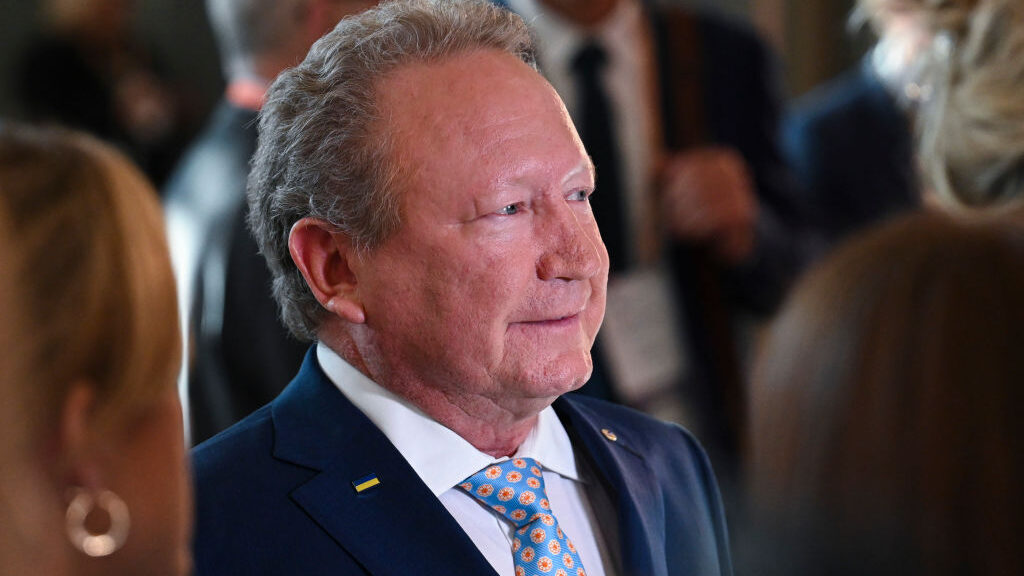Ground Breakers: FMG dividend falls as weaker iron ore prices force 15% profit cut and barely $850m for Twiggy

Pic: Martin Ollman/Getty Images via Getty Images
Andrew Forrest’s iron ore major Fortescue Metals Group (ASX:FMG) has dropped its interim payout by 12.8% after a 15% drop in profit after tax to US$2.368 billion ($3.4b).
The result acts as a preview to the major ASX miners, with FMG the first of the big Pilbara three alongside Rio Tinto (ASX:RIO) and BHP (ASX:BHP) to report its results this half year reporting season.
The firm will pay $2.3 billion in dividends to shareholders including ~$850 million to its major shareholder and executive chairman Forrest in the form of a 75c per share payout, down from 86c last year.
Following suggestions from analysts that FMG and other major miners would begin to curb payouts in the face of decarbonisation spending, capex and expanding M & A plans, FMG’s payout ratio fell from 70% last year to 65% this year, still in line with its policy to return between 50-80% of NPAT to shareholders.
The background to the weaker financial result was a lower realised iron ore price and higher costs on the previous year, with NPAT falling from US$2.777b in H1 FY22, with iron ore prices down from US$96/t to US$87/t and C1 costs up from US$15.28/t to US$17.43/t, with margins falling from US$58/t to US$52/t outside of its Fortescue Future Industries green energy division.
While prices were down on face value, FMG improved the realisation of its lower grade product to the Platts 62% Fe IODEX from 70% to 86%.
FMG delivered a record 96.9Mt of iron ore shipments in the first half of FY23, with underlying EBITDA of US$4.4b (56% margin, down from US$4.8b a year earlier) and NPAT of US$2.4b largely in line with consensus.
The ~$70 billion miner boasted US$4b of cash and US$2.1b in net debt as of December 31, with no changes to capex, cost or shipment guidance. It plans to deliver 187-192Mt of iron ore in FY23 at US$18-18.75/t.
Twiggy on earnings call
Those results were followed by a meandering and at times prickly financial results call, ranging from triumphalism at the long-term performance of the company and its green energy ambitions, to complaints about reporting on job losses at the miner by WA’s daily newspaper the West Australian, controlled by fellow billionaire Kerry Stokes.
A few interesting tidbits:
Forrest has no intentions of stepping down yet as an executive as Fiona Hick moves across from Woodside to become the new chief executive of the mining giant’s iron ore business.
But he has flagged the potential to loosen the reins and eventually return to a non-executive role as the miner’s green transition plans come to fruition.
Its FFI CEO Mark Hutchinson and Forrest have flagged five projects to progress to FID this year, including in Australia, Brazil, the US and Norway.
Responding to questions on the call, Forrest suggested he could eventually step back from the role he resumed last year once the company had achieved its transition aims.
“I will stay executive chairman as long as it takes to guide, to navigate the company through this massive transition period and then once that settles and I feel sure that we’ve met or that the three of us have met all the leadership challenges we need to then there will be two again … and I’ll step back to being non-executive.”
He later dialled back that commentary, saying at the end of the call a transition back to a non-executive role would not happen “any time soon”.
Forrest also suggested there could be 1.5Bt of high grade iron ore at its Belinga project in Gabon, where it signed a mining convention last week on the development of a small scale, 2Mt starter operation with a projected capex bill of around US$200m.
“We’ve been pretty conservative and said look, let’s take the initial operation to 2Mt and just trial everything, learn like crazy, we are completely comfortable with the operation being put together with sticky tape and binder twine mate, but it will be safe, our priority is safe,” he said.
“And I will get into production at a speed which you see in developments in Africa, which is breathtaking, and do that because of the ability to provide a very flexible, fast, efficient mining company with excellent infrastructure and export those skills and equipment straight into Gabon and use roads and use rail which already exist.
“And of course you’d like me to speculate … on scale, but you’ve just got to go on form mate.
“We did Cloudbreak at 40Mt, Christmas Creek at 50Mt, we looked at Solomon at 60Mt, each one of these has overperformed, Eliwana at 30Mt overperformed.
“And we have the ability we believe if we want to settle the show down at 50Mt and grow it from there, but look it is speculation, we think we’ve got a minimum of 1.5Bt of high grade, close to surface ore, it could be much, much larger than that, but it is a huge iron ore province which has totally taken the world by surprise.”
Meanwhile, FMG’s iron ore marketing chief Vivienne Tieu said China’s support for its property and infrastructure sectors was expected to translate to higher real steel demand later in 2023, with weak steel margins providing a marketing benefit for its lower grade Pilbara ores.
Iron ore prices have been strong in 2023 so far, lifting to over US$120/t, but some analysts and institutions have been cautious on the commodity, with Commbank’s Vivek Dhar suggesting yesterday a fall to US$100/t this year was likely given it expects the property sector to continue contracting.
Fortescue Metals Group (ASX:FMG) share price today:
More lithium blowouts as Wesfarmers update on Mt Holland
Wesfarmers (ASX:WES) is now almost three and a half years on from the completion of its $776m buyout of Kidman Resources, which delivered a half-stake in the 50-50 JV over one of Australia’s largest lithium deposits, the Mt Holland mine with SQM.
It is still to enter production, in part reflecting the long lead times and issues being seen by producers to add to and ramp up hard rock lithium production.
Wesfarmers has today flagged further delays, which come off the back of blowouts in cost and/or schedule at projects like IGO (ASX:IGO) and Tianqi’s TLEA Kwinina lithium hydroxide plant, Liontown Resources’ (ASX:LTR) Kathleen Valley lithium mine and expansions at Mineral Resources (ASX:MIN) and Ganfeng’s Mt Marion mine and Pilbara Minerals’ (ASX:PLS) Pilgangoora.
In its half year results today the West Australian industrial and retail giant, perhaps best known as the owner of the Bunnings brand and its iconic charity snags, said first production of lithium hydroxide at its own Kwinana refinery would now be six months later than previous guidance in the first half of calendar year 2025.
First earnings are expected in the first half of 2024 as it ramps up spodumene concentrate production at the Mt Holland mine near Southern Cross.
Wesfarmers now says capex for the project will be between $1.2 billion and $1.3 billion for its share of the mine and plant, with labour availability pressures, refinery engineering delays and Covid restrictions partly blamed for a 10-20% increase on its prior guidance of $1085 million, itself an adjustment from the original $950 million in real 2021 dollars.
Wesfarmers shares generally lifted after the company announced a 10% lift in its interim dividend from 80c in FY22 to 88c in FY23, with revenue up 27% to $22.558 billion, EBIT 13.4% higher at $2.16b and NPAT up 14.1% to $1.384b.
CEO Rob Scott said solid sales and earnings at Bunnings, together with strong earnings at Kmart and in its chemicals and fertiliser business were behind the bump.
Wesfarmers (ASX:WES) share price today:

UNLOCK INSIGHTS
Discover the untold stories of emerging ASX stocks.
Daily news and expert analysis, it's free to subscribe.
By proceeding, you confirm you understand that we handle personal information in accordance with our Privacy Policy.








